This article describes features that are only available in The Sims 2.
Small houses can be frustrating to play with, especially with large families of Sims. On top of this, making additions to the house may not be practical or desired, due to lot size, desired architecture or aesthetics. Fortunately, from The Sims 2 onward, it is possible to build a basement under a house. In up-to-date versions of The Sims 3 and The Sims 4, basements can be built using a dedicated basement tool.
Unfortunately, unpatched versions of The Sims 3 and all versions of The Sims 2 lack a basement tool, but basements can still be created through the use of foundations. However, the process to construct basements is not explained in-game. As a result, some players may not understand how they are constructed. Fortunately, building basements is quite simple, and can be done to any pre-existing house on a foundation, or to any new construction.
Step-by-step instructions
Note that the images included in the tutorial below demonstrate building a basement in a new lot. The steps listed out for building a basement in a pre-built house versus a house being constructed should not differ, unless otherwise mentioned.
Be aware that the methods of construction outlined here will only work in The Sims 2 and The Sims 3. The Sims does not feature foundations or a basement tool, so it is not possible to build under the lower level of any lot. The Sims 4 handles foundations in a different manner than The Sims 2 or The Sims 3, so building basements using foundations is not possible in that game. Up-to-date versions of The Sims 3 allow construction of basements using the basement tool, but building basements using foundations is still possible.
Note that this tutorial details building basements using the foundation tool. As such, basements cannot be added to buildings without foundations with this method.
- Step 1 - Select your site
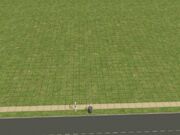
A nice empty lot, ready for construction
For the purposes of this tutorial, an empty lot has been chosen to demonstrate the construction of basements. If you are remodeling an already-existing house, move to Step 2.
Ideally, Basements should be built on flat lots, though there are exceptions to this. For beginner builders, level out the lot before building the foundation.
- Step 2 - Lay down foundation
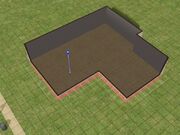
Foundation and main floor walls already placed
To start, lay down the foundation for the building, as you would if you were building a house without a basement. You can begin to build the above-ground portions of the building right now, or you can choose to wait until the basement is complete.
- Step 3 - Hollow out the foundation

Foundation has been hollowed out
Use the foundation tool and hold the Ctrl key to remove the foundation, excluding a one-tile-wide foundation around the perimeter of the future basement. The basement does not need to be as large as the house above it, so you can leave some parts of the first floor foundation alone if you do not want a basement built below it.
Note that if you're adding a basement to a house, you may want to copy the floor tiles with the Eyedropper Tool, since removing the foundation will also remove the floors on top of it.
- Step 4 - Paint the foundation
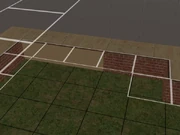
A couple segments of foundation have been painted
Find a wallpaper or other wall covering to place on one or more sections of the foundation inside the hollowed-out area. The covering chosen does not matter, except that it should have a pattern, a baseboard or some other feature that will allow you to determine the height of the wall.
- Step 5 - Start digging

A couple segments of foundation have been painted
Using the lower land tool, start digging a hole near the foundation that you've painted/covered, exposing the entire length of the painted wall. Use the patterns or baseboard on the paint you've chosen to help you find the depth of the hole you're digging. The approximate number of times clicked to make the ground for the basement the correct level to add a staircase is 12.[1]
- Step 6 - Level out the basement
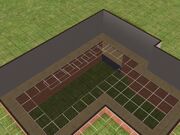
The inside of the basement has been leveled out
Once you are able to get a tile of land inside the basement to the correct level, use the level land tool to lower the rest of the land inside the hollowed-out foundation to the same level. Afterwards, look around the outside of the foundation perimeter to make sure you didn't create any holes.
- Step 7 - Remove the foundations around the basement

Perimeter foundation has been removed
Once you've reached this step, the basement is already usable. However, because foundation walls are not treated as normal walls by the game, it's useful to remove the foundation around the perimeter of the basement, and to place walls down.
- Step 8 - Place walls down around the basement perimeter

Walls have been built around the basement
The walls placed in this step are normal walls, and can have objects placed on them. If the walls are not connecting to the foundations correctly, the basement depth may not be right.
- Step 9 - Rebuild the perimeter foundation
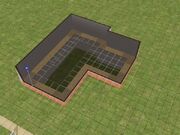
Foundation around the perimeter has been replaced
Once the basement walls are built, rebuild the foundation around the base of the building.
- Step 10 - Place stairs
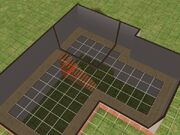
Stairs into the basement have been built
Finding a good location for the stairs may be difficult. You might be able to find a good spot for the stairs by placing some of the walls on the main level.
- Step 11 - Finish the basement

The basement has been finished
Complete the basement, just as you would other rooms in the building. Your basement should now be finished!
References

